Obviously, if you’ve been stung by a bee, you know it’s not a sweet experience. And it’s not just about the bee puns — a sting from this insect can leave you swollen for about seven days. Metaphorically speaking, bee stings signify that good things eventually come despite the pain they cause.
Bees play a vital role in ecosystems — they are master pollinators, sustaining the survival of many plants and animals. Pollination is the process through which plants reproduce, thereby maintaining biodiversity. To put it into context, bees pollinate 75% of plants globally and about 80% of all flowering plants. Without bees, the food supply would reduce significantly, and many plants would face extinction.
In the wild, bees’ honey is a source of food for several animal species, including bats, birds, and some insects. Also, humans have harvested honey from bees since ancient times, relying on them as a natural sweetener in food.
While bees are vital players in our ecosystems, they pose a risk to human health and safety. As such, it’s important to be aware of the different types of bees present in Texas and where they typically swarm.
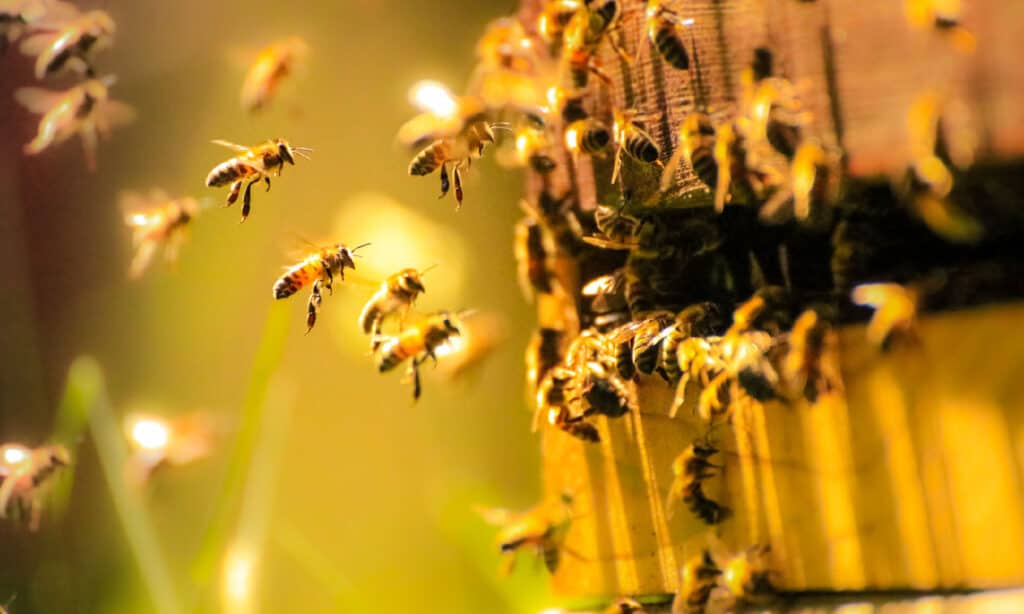
The honey produced by bees is a source of food for several animal species, including bats, birds, and some insects.
©iStock.com/William Jones-Warner
Types Of Bees Found In Texas
Texas is home to various bee species native to the state, while some are migratory or new to the area. These species are easily identified through their distinctive physical characteristics. Bee species native to Texas include:
Honey Bees
Honey bee (Apis mellifera Linnaeus) are insects under the order Hymenoptera. They come in many color variations, including shades of brown, black, or brown mixed with yellow. The honey bee larvae are white in color and legless. The honey bee species have hairs on the pronotum and abdomen.
Under the broader honey bee species are several subspecies purposefully bred for honey production, disease resistance, and temperament. The subspecies have distinguishing colors and sizes.
Bees thrive in swarms because they are social insects. A swarm comprises workers, drones or males, and a queen. The queen mates with the drones to produce eggs, while the workers are non-reproducing females. Queens lay the eggs specifically in the hexagonal cells in the combs. Larvae hatch after three to four days, and the worker bees feed them until they are fully developed.
Drones and queen larvae are more extensive than worker bees. Also, they require larger cells than the workers’ larvae. Worker larvae develop in 21 days while the drones develop in 24 days; the queen takes fewer days (fifteen and half days).
There is only one queen in a single hive. If a queen ages, dies, or the colony enlarges, worker bees develop a queen through differential cells. The formation of a new territory entails a virgin queen flying out with drones from her colony or elsewhere to mate. When a mated queen flies out with worker bees, the process is called swarming. And when they settle in a new hive, they’ll form a new colony.
Bees live in artificial hives, hollow trees, or some sheltered habitat. Worker bees collect nectar and pollen. Pollen is carried in a pollen basket, a structure on the hind legs, while the nectar is carried through honey sacs on the front part of the digestive system. Pollen is stored in the cells found in the combs in the hive. Worker bees feed the queen, drones, and larvae.
Honey is made when bees regurgitate nectar, adding the enzyme invertase to complete the conversion of sugar.

Bees thrive in swarms because they are social insects, with each swarm comprised of workers, drones or males, and a queen.
©iStock.com/Inventori
Bumble Bee
Remember Bumblebee in the movie Transformers? He’s the yellow and black robotic Chevrolet Camaro, initially a Volkswagen beetle. The creator of the bumblebee character was right on the colors; bumblebees mostly have yellow and black stripes.
Bumblebees are fuzzy and have a distinctive buzzing sound. They live in colonies comprising the queen bee, female workers, and males. In Texas, there’re several subspecies of bumblebees, including the American bumblebees (Bombus pensylvanicus), the brown-belted bumblebee (Bombus griseocollis), and the two-spotted bumblebee (Bombus bimaculatus).
In comparison with honeybees, Bumblebees are larger. A queen bumble bee is bigger than drones and workers. Even so, the sizes vary among species. Some larger bumblebee species measure 0.9 inches, while drones measure 0.5 inches and the workers between 0.4 and 0.7 inches. Also, they have longer tongues adapted to the nectar collection. The largest bumblebee species in Chile, Bombus dahlbombii, measures 1.7 inches long.
Bumblebees primarily feed on pollen and nectar. Their tongue is usually long and hairy, making lapping on the liquid easier. The nectar makes honey, while the pollen is food for their larvae. While Bumblebees are well adapted to high altitudes and latitudes, you’ll still find some subspecies in Texas. Bumblebee species, such as the Bombus Polaris, can survive in regions near the high Arctic.
Average bumblebee colonies have 40-400 bees; some will accommodate over 1700 bees, while smaller ones can have only 20 bees. But this is extremely small compared to honeybee colonies, with over 50,000 bees per colony. Some bumblebee species nest in thick grass or trees, while others hide underground to protect against high temperatures.
Worker bumblebees have a lifespan of 28 days, while the queen can survive for a few months, especially before her colony dies out. Bumblebees’ major threats are unfavorable climatic conditions, disease, pesticides, or habitat loss.
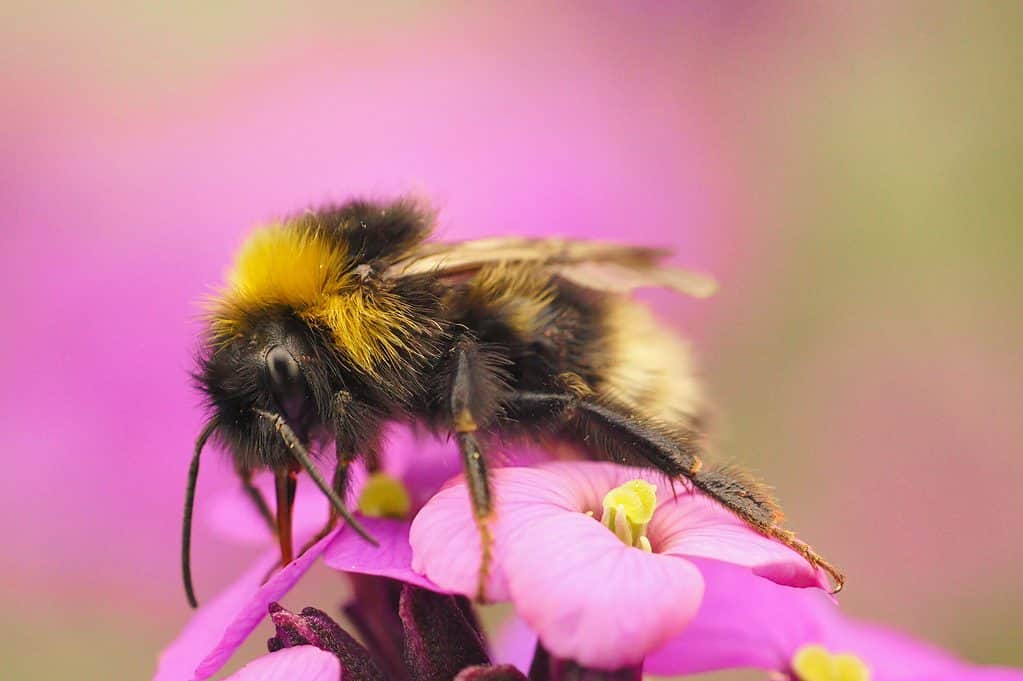
Bumblebees are fuzzy and have a distinctive buzzing sound.
©HWall/Shutterstock.com
Carpenter Bees
There are 35 subspecies of carpenter bees throughout the USA, particularly in Texas. Carpenter bees are small, measuring three-quarters to one inch long. They love making homes in hollow pith or stems of wood or plants, decaying woods, hence the name ‘carpenter bees’. But seven subspecies can nest in usable wood damaging the structures.
Softwood is their choicest nest area, such as pine, cypress, redwood, and cider. However, they attack hardwoods, especially after decaying or undergoing exposure to dilapidating elements. Their hue is shiny or metallic blue-black with a greenish or purplish sheen.
The Xylocopa subspecies, commonly known as the carpenter bee, is similar to the bumble bee in color and size. Most of their bodies are covered with orange or yellow colored hairs, just like the Bumblebee species.
Their female worker bees have large pollen baskets and thick brush of hairs in the rear legs. One way of distinguishing holes on wood made by carpenter bees from other insects is through the size and shape: it’s a nearly perfect round entrance with half an inch diameter. Other insects make smaller entrances.
It’s worth noting that some carpenter bees die during winter. To protect themselves, they hide from the biting cold. Male carpenter bees will fly aggressively as a sign to mark their territory. However, this should not worry you since they don’t sting. But the female carpenter bees will give a painful sting if provoked. Carpenter bees become pests if they:
- Cause leaks in wooden cisterns
- Weaken structural strength of wood
- Bore tunnels in ornamental plants
- Threaten people
- Destro the aesthetic appeal of finished wood.
To prevent the carpenter bees from attacking your plants or lumber, treat your wood, and use polyurethane or oil-based paints. Wood sealants might also deter attacks temporarily.
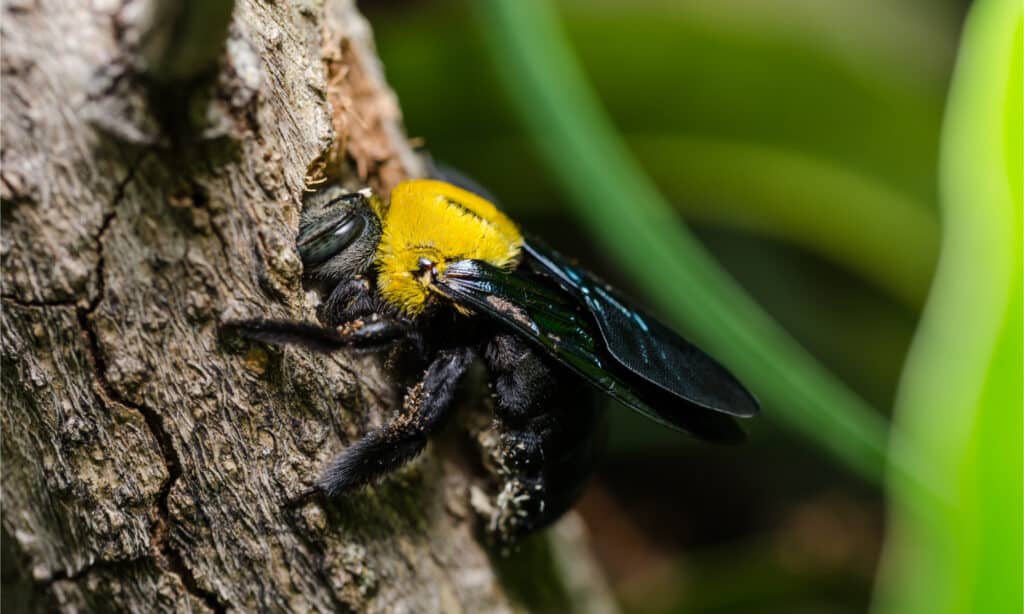
Carpenter bees have a shiny or metallic blue-black hue with a greenish or purplish sheen.
©SweetCrisis/Shutterstock.com
Mason Bees
Mason bees were named for their ability to use soil and plant parts to build nests. Also known as Osmia bees, mason bees have other subspecies: Ashmediealla and Heriades. Mason bees use leaves, resin, and mud to create partitions and walls in their nests. Usually, they prefer building nests in bored pithy stems, burrowed-out holes, and rarely in rock cavities or soil.
In Texas, mason bees are found in Rio Grande, where they use the succulent flesh of cactus as construction materials. Osmia subfasciata subspecies are known to forage on the wild gamut of plants. As solitary insects, these subspecies build their nests in abandoned wasp nests and snail shells or beetle burrows. Their mortar comprises chewed-up plants mixed with soil or coarse sand.
The Osmia subfasciata subspecies larvae pupate for almost 90 days. They’ll first emerge in August in Texas and in March as a continuation of their lifecycle. The female mason workers carry pollen on scopal hairs located in the underbelly. They come in several colors: electric orange, white, black, dark brown, and yellowish.
Mason bees have large heads, but with relatively small bodies. Some subspecies have bodies covered in hair, including some with stripped hair on their abdomens. Mason bees play a critical role in pollination, helping to fertilize plants and trees. They’re found in many parts of Texas, especially during the early summer and spring months.
They pollinate several plant species, including woodlands, wildflowers, desert plants, and grasslands. Other subspecies common in Texas (Osmia ribifloris, Osmia georgica, Osmia chalybea) pollinate cranberries, strawberries, melons, and blueberries.

Mason bees were named for their ability to use soil and plant parts to build nests.
©Jaco Visser/Shutterstock.com
Sweat Bees
Sweat bees are aptly named because of their attraction to perspiration, particularly the salts and moisture in the sweat. They are also attracted to other forms of moisture, such as nectar in flowers.
There are over 3500 species of sweat bees worldwide, and five hundred of these are found in North America. They are classified as small to medium-sized, measuring 0.39 inches long. Sweat bees come in color variations such as black, metallic green, brown, and bright purple or blue.
Typically, sweat bees have distinctive long tongues and hairy bodies which assist in collecting pollen and nectar. On the other hand, their hairy bodies help transport pollen between flowers. Sweat bees have relatively short lifespans, with most species surviving only a few weeks or months. They’re mainly involved in mating, foraging for food, and building nests in their short lifespans.
In Texas, sweat bees usually live in various habitats, including grasslands, forests, and deserts. In the urban setting, they can buzz around parks and gardens within Texas. Usually, sweat bees are harmless to humans and will occasionally sting if provoked, threatened, or disturbed. However, they deliver relatively mild stings and most people only experience minor pain and swelling.
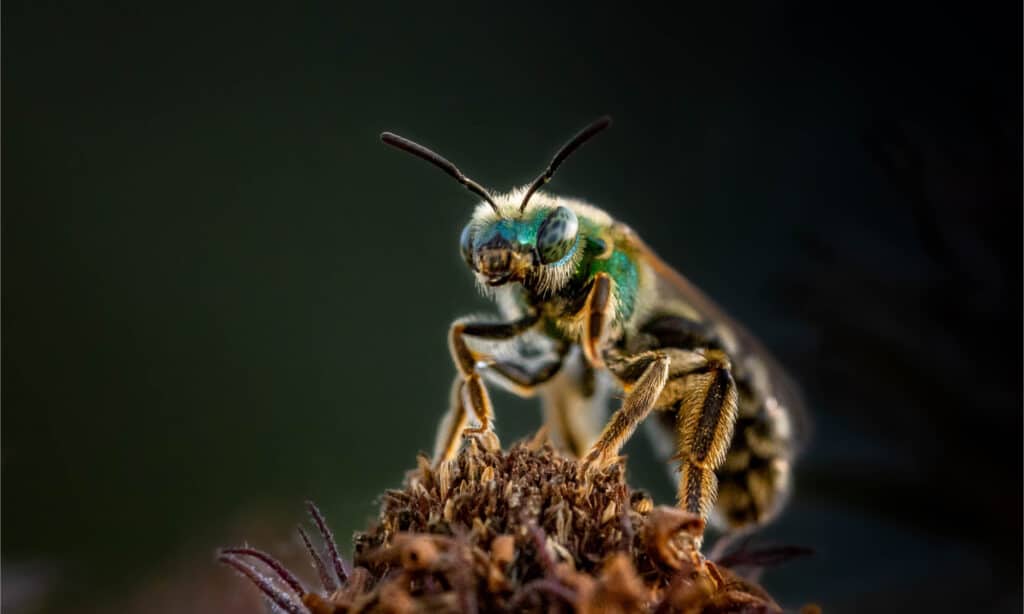
Sweat bees are aptly named because of their attraction to perspiration, particularly the salts and moisture in the sweat.
©d murk photographs/Shutterstock.com
Where Do Bees Swarm In Texas?
As stated earlier, swarming is when the virgin queen bees fly, ready to mate with a drone, hoping to set up a new home. Usually, you’ll see a swarm of bees clustered together in a large mass, flying in search of a new home. In Texas, bees are known to swarm in various locations.
Swarming is a natural instinct in a bee’s life that’s critical for survival. Swarming in Texas occurs between spring and early summer. So where do bees swarm in Texas? Trees offer bees shelter and protection and act as a food source. If bees swarm on a tree, they gather around a trunk or branch.
Bees might also swarm on buildings such as sheds, homes, and barns. In such a case, the bees enter via small openings such as wall cracks or a roof gap. Once inside, the bees construct a new hive in the ceilings or walls, which may cause problems for the homeowners.
You can also find bees swarming in the parks and other outdoor areas. Parks have flowers and plants that attract bees to these areas. They’ll cluster together in a swarm searching for a new home.
Sometimes they’ll swarm in unusual locations, such as bicycles and cars. Usually, this happens when the swarm of bees is in transit and stops temporarily before moving on to the next area. Should you encounter a swarm of bees in Texas, stay calm and avoid startling them.
In most cases, swarms of bees are generally docile and pose no risk to humans. However, it’s still important to protect yourself and the bees by calling a beekeeper or pest control professional to safely remove the swarm.
This way, the bees can be relocated to a safe, new home where they can continue playing their important role in the local ecosystem.
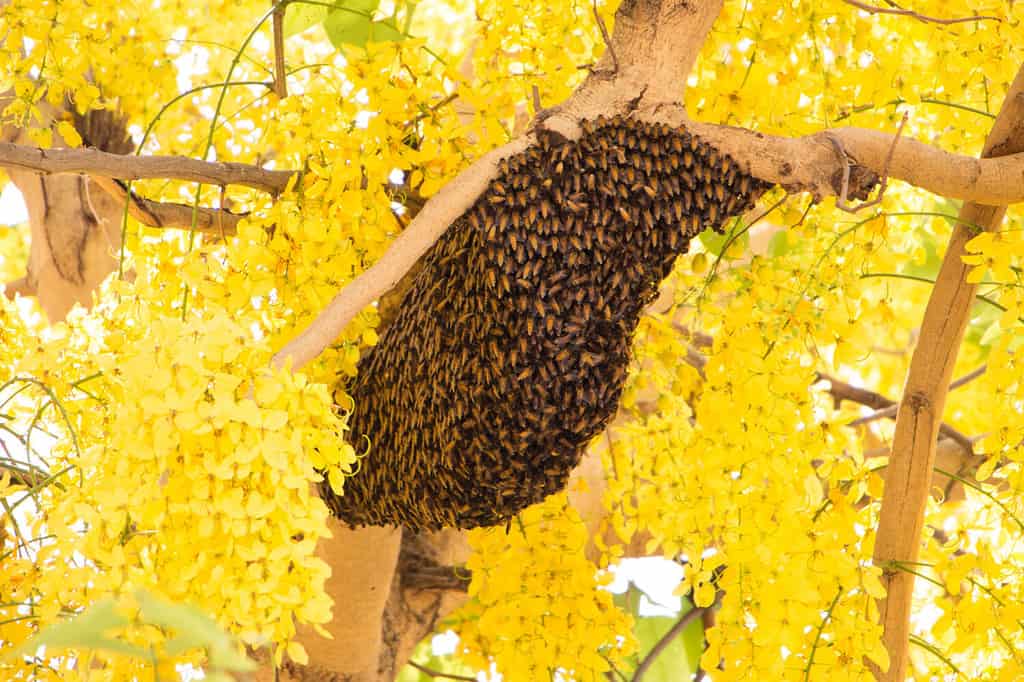
Swarming in Texas occurs between spring and early summer where bees may be seen on a tree, gathering around a trunk or branch.
©Infinity_Pok/Shutterstock.com
What’s Special About Bees In Texas?
Bees contribute immensely to the Texan ecosystem through pollination and creating balance in biodiversity. Texas’ warm climate and diverse habitats open up a wide range of bee species that thrive in the state, including bumblebees, carpenter bees, sweat bees, and honey bees.
Texas also boasts an abundance of flowering plants and trees, which provide food for these bees. The flowers attract them to parks and gardens where they forage and pollinate.
While some species of bees can sting, most are harmless and will only do so in self-defense. Therefore, it’s important to understand their habits and function, so we can effectively protect them. By understanding where bees swarm and how to identify different bee species, we can enjoy coexisting with these vital creatures.
The photo featured at the top of this post is © Daniel Prudek/Shutterstock.com
Thank you for reading! Have some feedback for us? Contact the AZ Animals editorial team.







